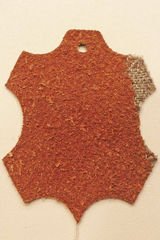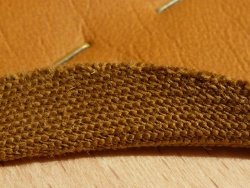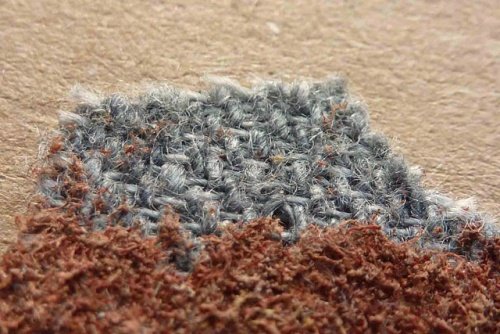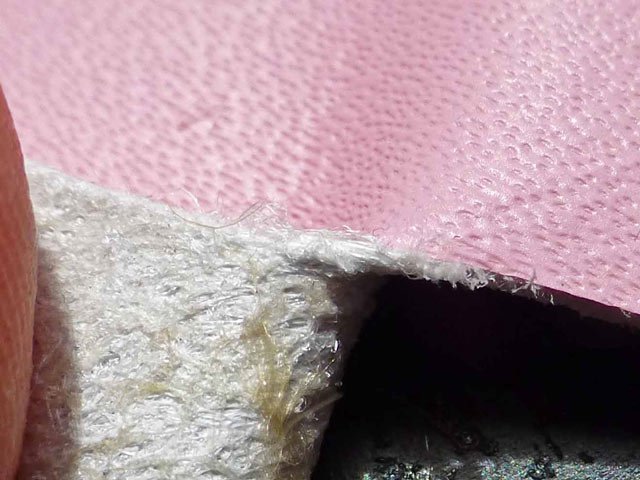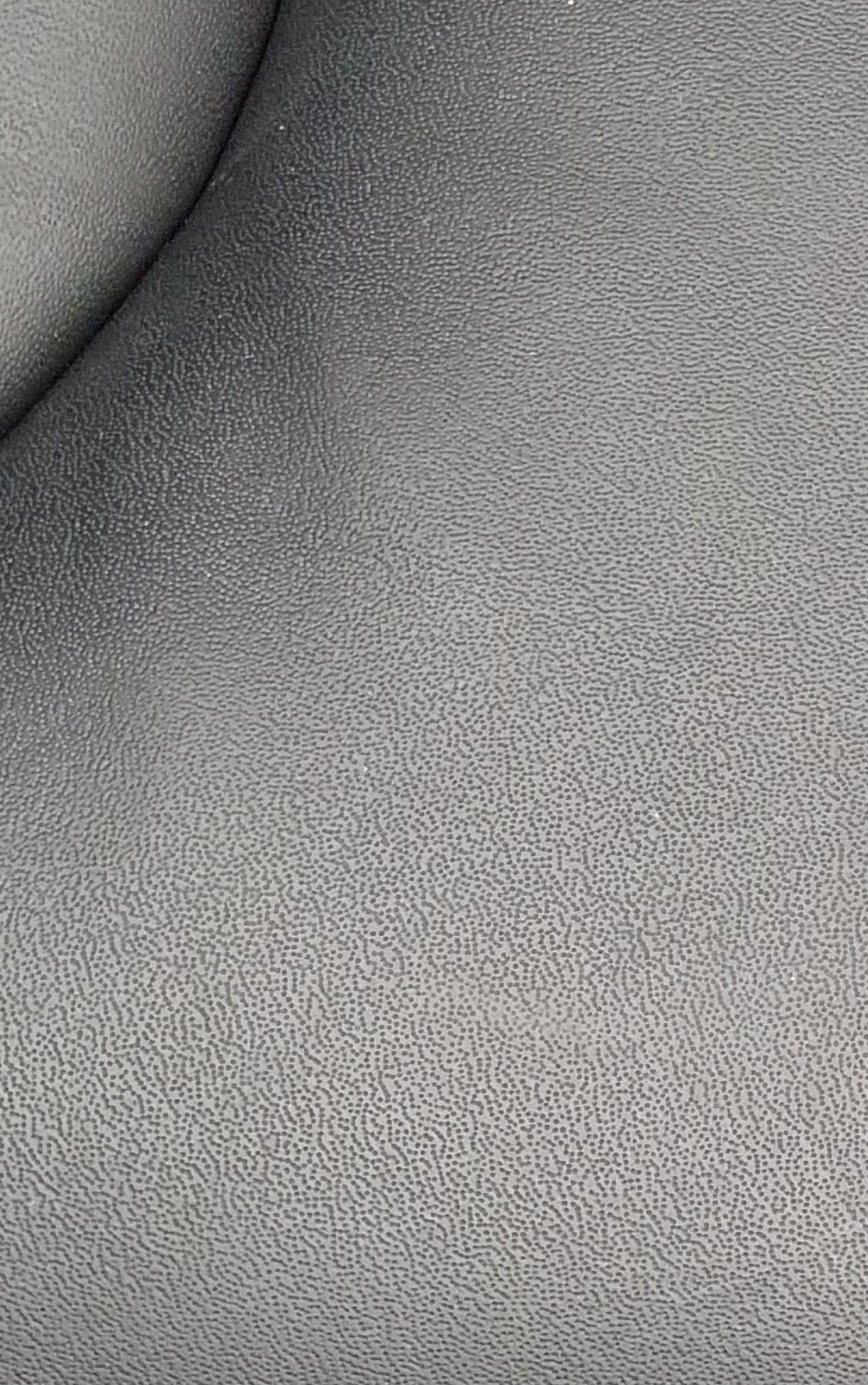
What is Artificial Leather.
As the name suggests, it is imitation leather that looks like leather. It usually consists of a textile backing, which is covered by layers of synthetic polymers. Leather grain is then embossed onto the surface.
Picture Credit: Colourlock® International.
Artificial Leather has succeeded in visually imitating top grain leather to the point where it is impossible distinguish the two by sight alone. Not only grain pattern are embossed, hair pores can be impressed to mimic the top grain look. Even the backing of Artificial Leather is designed to look like genuine leather, with leather fibres glued to its textile backing.
Similarly, consumers often find it difficult to recognise the difference between Suede and Alcantara, a high-quality microfibre that has similar napping to Suede.
While Artificial Leather has not yet matched top grain leather in breathability, haptics, water permeability and tensile strength, it can be micro-perforated to enhance its breathability. High-quality version even mimic the creak of genuine leather.
The true difference becomes apparent when Artificial Leather is damaged during regular use, highlighting the need for clear labelling to avoid misleading consumers.
Picture Credit: Colourlock® International.
Picture Credit: Colourlock® International.
However, Artificial Leather is well-suited for applications where frequent replacement, open weather or cleaning with strong agents is necessary. For instance, in a dentist’s chair, it is regularly treated with solvent-based disinfectants that would dissolve genuine leather’s finish and make it brittle. In high-traffic restaurants, it is more cost-effective to re-upholster with Artificial Leather than to restore genuine leather.
Differentiating Artificial Leather
Modern Artificial Leather is so well-made that even experts cannot be certain at first glance. Needless to say, consumers would find it difficult to distinguish between Artificial and Genuine leathers.
In the following section, some of the main features will be discussed to aid understanding. Only experienced experts who handle Artificial Leather daily can quickly identified it.
Next: Above is Artificial Leather, while Below is Pigmented Top Grain. Notice how the grain pattern on Artificial Leather is uniform, whereas grain pattern on top grain varies across different parts of hides, being strong in some areas and fine in others.
The following sections briefly discuss the characteristic of Artificial Leather. Understanding these characteristics aids in differentiating it from genuine leather. Just like top grain and split leathers, Artificial Leather comes in variants and different quality levels. Therefore, the following are broad pointers for Artificial Leather in general.
Reverse Side
Artificial Leather typically has a textile backing onto which a smooth or embossed plastic film is coated. Some types of Artificial Leather also have leather fibres glued to the backing, making them look like reverse side of top grain or split leathers.
In products where the back of the material cannot be accessed without disassembling, for example a handbag, it is advisable to have a description of the leather purchase written on the invoice when in doubt.
Haptic and Breathability
Artificial Leather feels colder and stiffer, much like PU and Laminated leathers. The lack of breathability causes skin to perspire and make it stick onto Artificial Leather.
Cutting Edge
The cutting edge is often smooth and clean, whereas top grain or split leathers will have lint-like edges.
Burn Test
Artificial Leather melts at high heat and burns readily, emitting a smell like burnt plastic. In contrast, genuine leather glows and solidifies without catching fire, and it smells like burnt hair.
Pinch Test
Artificial Leather often feels thin when pinched and folds like paper. With its textile backing, it can only stretch in one direction, whereas top grain can stretch in all directions.
Damages
Unfortunately, it is when damaged that experts can be certain if the leather is artificial. Cracks will appear first, eventually developing into tear and peeling off. These damages cannot be repaired and there is no care product or method to soften Artificial Leather.
Labelling
In automotive and furniture applications, it is common for contact points to be upholstered in genuine leather while the rest of surfaces are covered in artificial leather. Most consumers are unable to distinguish the difference, making accurate labelling essential. Products without such label should not be trusted.
Vegan Leather
Picture Credit: Colourlock® International.
When product is labelled as “Vegan Leather”, it does not automatically mean that it is environmentally friendly, biodegradable, or made from recycled materials. Most top grain leathers are by-products of the meat industry, which may explain why tanneries are usually located near slaughterhouse. One of the few exceptions is crocodiles, which are primarily breed for their hides.
Modern tanneries in developed countries adhere to strict sustainability standards, such as Zero Discharge of Hazardous Chemicals (ZDHC) program, making them as safe as other chemical manufacturing plants.
Many people associate natural substances with Vegan Leather, likely because of the term “Vegan” is commonly used in nutrition. In reality, Vegan Leather is often made from microplastics, which may generate more plastic waste. For example, Pinatex, made from fibres extracted from pineapple leaves, is non-biodegradable because polylastic acid and petroleum-based substances are added to it.
In contrast, Wine Leather, another type of Artificial Leather, is described as total ecological as it is 100% made from grape skins, stalks and seeds of wine grapes.
Conclusion
Synthetic leather finds widespread use in various industries, including automotive, footwear, handbags, furniture and clothing. It surpasses genuine leather in application where there is consistent exposure to sunlight and water.
Besides cost savings, Artificial Leather is proved advantageous in settings requiring heavy cleaning and regular disinfection. However, there are highest-quality segment where the imitation leather is extremely robust. For example, in Louis Vuitton products, the areas with printed logos are exceptionally robust.
Most Artificial Leathers have a PVC coating on the surface. Damage is typically caused by the migration of softeners, which is removable by solvent-based cleaners. Therefore, it is important to check if cleaners contain hydrocarbon as damage on Artificial Leather cannot be repaired
We have now familiarised ourselves with Top Grain, Split and Artificial Leathers. In next chapter, we will discuss about factors that affect leather quality, as well as natural marking and injuries. Understanding these factors will aid in differentiating Top Grain and Split Leathers and elevate our appreciation for this natural material.
DID YOU KNOW…
Stretch Leather is a thin and pliable Pigmented Top Grain lined with a special stretch material on the back. This reverse fabric backing might lead some to mistakenly perceive it as split leather with fabric.
Also available with Suede, this composite leather is high elastic, does not expand due to movements and body heat, yet preserve its body-hugging properties.
Stretch Leather is commonly used in fashion industry.
Picture Credit: Colourlock® International.


